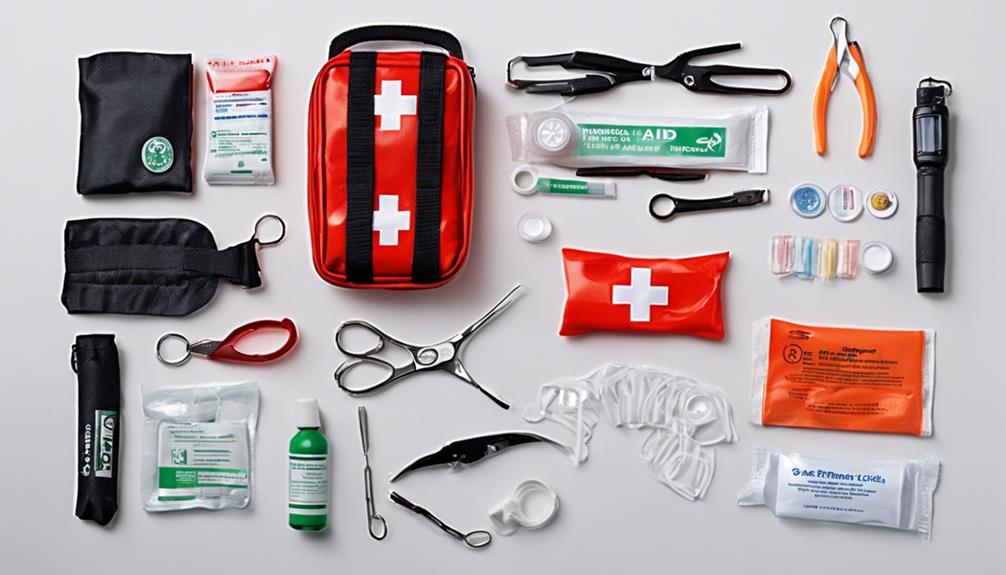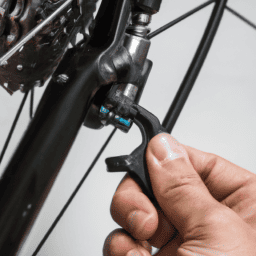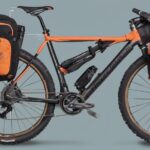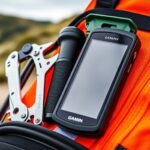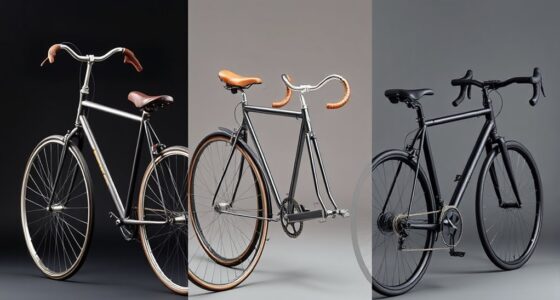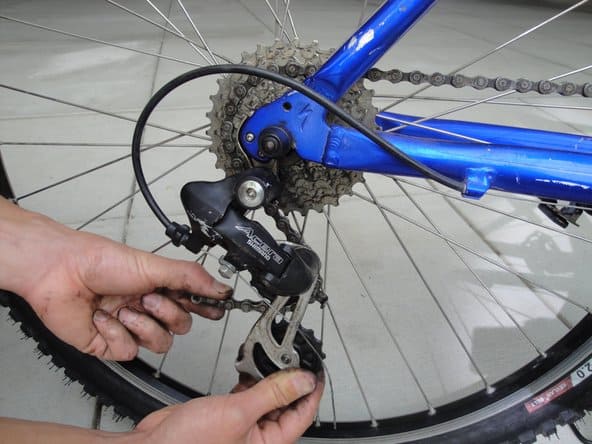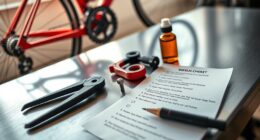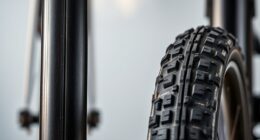When hitting the trails on our bikes, having a well-equipped first aid bag is crucial for handling any unforeseen situations. Ensuring that we have the right items readily available can be a game-changer in dealing with emergencies during our rides.
From simple cuts and scrapes to more serious injuries, being prepared with the top 10 must-have items in our bicycle first aid bag can make all the difference in ensuring a safe and enjoyable cycling experience.
Key Takeaways
- Include adhesive bandages for covering cuts and scrapes, promoting quick healing.
- Antiseptic wipes are essential for cleaning wounds and preventing infections on the go.
- Carry gauze pads to absorb blood, prevent infections, and aid in wound care.
- Ensure pain management with pain relievers like ibuprofen, antihistamines for allergies in your first aid kit.
Adhesive Bandages
We always ensure our bicycle first aid bag includes a variety of adhesive bandages to cover small cuts and scrapes encountered during cycling. Adhesive bandages are essential for addressing minor wounds while on the go.
They play a crucial role in protecting small cuts from dirt and bacteria, promoting quicker healing, and preventing further injury. These bandages come in different sizes, shapes, and materials to cater to various types of wounds cyclists may experience.
Their convenience and ease of application make them a must-have item in any cyclist's first aid kit. By having a selection of adhesive bandages on hand, we can promptly address any small cuts or scrapes that may occur during our rides, allowing us to continue cycling with peace of mind.
Antiseptic Wipes

Antiseptic wipes are crucial for effectively cleaning and preventing infections in minor wounds. Their convenient individually wrapped packaging makes them easy to carry in a bicycle first aid bag.
Including antiseptic wipes ensures proper wound care and reduces the risk of complications while cycling.
Wound Cleaning Essentials
When cycling, it's crucial to have wound cleaning essentials like antiseptic wipes in your first aid bag to prevent infections and promote proper wound care. Antiseptic wipes are convenient, portable, and effective for on-the-go wound cleaning. These wipes contain antiseptic agents like alcohol or benzalkonium chloride, which help kill bacteria and reduce the risk of complications from minor injuries.
Including antiseptic wipes in your bicycle first aid kit is a proactive step to ensure you can address any wounds promptly. Remember, proper wound care with antiseptic wipes can make a significant difference in how quickly and effectively your injuries heal during cycling emergencies.
- Convenient and portable
- Contains antiseptic agents like alcohol or benzalkonium chloride
- Helps kill bacteria and prevent infections
- Promotes quick and effective wound care
Prevent Infection Effectively
After addressing wound cleaning essentials, the next critical step is to focus on effectively preventing infections using antiseptic wipes in your bicycle first aid bag. Antiseptic wipes are crucial for infection prevention in minor wounds as they contain antibacterial agents that help clean the affected area and reduce the risk of bacterial contamination. They are convenient, portable, and easy to use, making them ideal for on-the-go first aid care during cycling. Using antiseptic wipes promptly after an injury can help minimize the chances of developing an infection, promoting faster healing. Including antiseptic wipes in your bicycle first aid kit ensures you have a reliable way to disinfect minor wounds and maintain proper hygiene while cycling.
| Antiseptic Wipes | Infection Prevention | Minor Wounds |
|---|---|---|
| Antibacterial | Reduces contamination | Promotes healing |
Gauze Pads

Gauze pads play a crucial role in proper wound care by absorbing blood and preventing infections. They're versatile, coming in various sizes to address different types of injuries effectively.
Including a range of gauze pad sizes in our bicycle first aid kit ensures we can handle various wounds and minimize infection risks.
Proper Wound Cleaning
In our bicycle first aid bag, we always include gauze pads for effective wound cleaning and protection. Gauze pads play a crucial role in proper wound care by absorbing blood and fluids while preventing infections.
Here are some key points to remember about gauze pads:
- Essential for preventing infection and promoting healing.
- Come in various sizes, such as 2×2 inches, suitable for different wounds.
- Non-adherent to wounds, reducing pain during dressing changes.
- Can be secured with adhesive tape or bandages for added protection.
Having gauze pads in your first aid kit ensures you're prepared to handle a variety of injuries effectively.
Dressing Wounds Effectively
When dressing wounds effectively, it is crucial to properly select and apply gauze pads to promote healing and prevent infections. Gauze pads are essential for absorbing blood and other fluids, aiding in the healing process. These pads come in various sizes, such as 2×2 inches, to cover wounds adequately. They are non-adherent, ensuring they do not stick to the wound and cause additional discomfort. Individually packaged gauze pads maintain sterility, reducing the risk of infection during first aid use. Proper application of gauze pads can help control bleeding, shield the wound from contaminants, and facilitate healing for various cycling injuries.
| Key Point | Description | Benefits |
|---|---|---|
| Absorb Blood and Fluids | Gauze pads absorb blood and fluids to aid in the healing process. | Promotes healing |
| Various Sizes Available | Different sizes, like 2×2 inches, cater to covering wounds of varying sizes. | Fits different wound sizes |
| Non-Adherent | Non-adherent properties prevent sticking to the wound during dressing changes. | Reduces pain and damage |
| Individually Packaged | Individually packaged for maintaining sterility and reducing infection risks. | Ensures cleanliness |
| Facilitate Healing | Proper application helps control bleeding, protect the wound, and aid healing. | Supports the recovery process |
Preventing Infection Risks
To safeguard against potential infections, incorporating gauze pads in your bicycle first aid kit is crucial for promoting wound healing and maintaining cleanliness. Gauze pads act as a sterile barrier, protecting the wound from outside contaminants.
Here are some key points to consider about gauze pads:
- Gauze pads are available in various sizes, making them versatile for different wound sizes.
- They can absorb blood and other fluids from the wound to promote healing.
- Properly applying gauze pads helps create a clean environment for wound healing.
- Using gauze pads can reduce the risk of complications and aid in the overall healing process.
Adhesive Tape

Securing dressings and bandages during cycling accidents is made easier with the versatile and reliable hold provided by adhesive tape. This essential item ensures that bandages stay in place, preventing further injury or contamination. Adhesive tape is compact and lightweight, fitting perfectly into any bicycle first aid kit. Its strong hold is crucial for keeping wounds protected while you continue your ride. Here's a quick look at why adhesive tape is a must-have in your cycling first aid bag:
| Benefits of Adhesive Tape | Description |
|---|---|
| Versatile Hold | Keeps bandages secure during movement. |
| Easy to Cut | Can be tailored to different wound sizes. |
| Compact | Takes up minimal space in your kit. |
| Lightweight | Ideal for carrying on cycling trips. |
With adhesive tape on hand, you can swiftly address any cuts or injuries that may occur while enjoying the freedom of the open road.
Tweezers

Having a reliable pair of tweezers in your bicycle first aid bag is essential for addressing minor injuries and removing foreign objects from the skin. Tweezers play a crucial role in managing skin injuries while biking, allowing for quick removal of splinters, thorns, or small debris that may cause discomfort or lead to infections.
Here are some key points about tweezers:
- Tweezers are versatile tools designed for precision in extracting foreign objects from the skin.
- They come in various sizes and shapes, with pointed or slanted tips to cater to different needs.
- Lightweight and compact, tweezers are easy to carry in a bicycle first aid bag or pocket.
- Quality tweezers with a good grip can make it easier to remove embedded objects from the skin during outdoor activities like biking.
Including tweezers in your first aid kit ensures that you can promptly address minor wounds or irritations, promoting a safer and more comfortable biking experience.
Scissors

When it comes to our bicycle first aid bag, scissors play a crucial role in our emergency preparedness. These versatile tools are essential for cutting bandages, clothing, or other materials when needed.
It's important to choose scissors with blunt tips for safety and consider features like serrated edges for better grip and precision.
Essential Cutting Tool
We recommend including a pair of sharp and compact scissors in your bicycle first aid bag for efficient cutting during emergency situations. When choosing scissors for your kit, opt for ones with rounded tips to avoid accidental injuries. Ensure they're sharp and durable to cut through various materials easily. Compact and lightweight scissors are ideal for a bicycle first aid bag, as they won't add bulk. For more heavy-duty cutting tasks in emergencies, consider adding a pair of trauma shears to your kit.
- Choose scissors with rounded tips to prevent accidental injuries.
- Ensure scissors are sharp and durable for cutting through various materials.
- Opt for compact and lightweight scissors to fit easily into your first aid bag.
- Consider adding trauma shears for more heavy-duty cutting tasks.
Safety in Emergencies
Scissors are a crucial tool for ensuring safety in emergencies by enabling quick and precise cutting of materials in a bicycle first aid kit. They play a vital role in emergency situations, allowing for the efficient cutting of bandages or clothing to attend to injuries promptly. It is important to select scissors with rounded tips to prevent accidental skin punctures during use. By having scissors in your first aid bag, you can respond effectively to various medical situations while cycling. Compact and lightweight scissors are ideal for inclusion in a bicycle first aid kit, as they provide the necessary cutting capabilities without adding extra bulk or weight.
| Features | Description | Importance |
|---|---|---|
| Quick Cutting | Enables fast material cutting | Essential |
| Rounded Tips | Prevents skin punctures | Safety Measure |
| Lightweight | Easy to carry in first aid kit | Convenience |
Versatile Tool Usage
In emergencies, the versatile usage of scissors in a bicycle first aid bag extends to quickly and efficiently cutting materials like bandages and clothing for prompt injury care. Scissors are indispensable tools for accessing and treating wounds, as well as removing clothing to assess injuries during emergencies. Opting for scissors with rounded tips enhances safety in first aid situations, preventing accidental cuts or punctures on the patient's skin. Compact and durable scissors are ideal for fitting into a bike first aid kit without occupying excessive space. With scissors readily available in your first aid bag, you can respond effectively to various medical situations while cycling.
- Efficiently cut bandages and clothing
- Essential for treating wounds
- Opt for rounded tips for safety
- Compact and durable for bike first aid kits
Pain Relievers

When cycling, it's crucial to have pain relievers like ibuprofen or acetaminophen readily available in your first aid bag to alleviate common discomforts such as muscle aches or joint pain. These medications can help reduce inflammation and manage minor injuries or muscle strains while on the road. It's advisable to carry pain relievers in individual packets or a small container for easy access during rides. Non-steroidal anti-inflammatory drugs (NSAIDs) are often recommended for pain relief in cycling first aid kits. Remember to check the expiration dates of pain relievers regularly to ensure their effectiveness.
| Pain Relievers | Description |
|---|---|
| Ibuprofen | Effective for reducing pain and inflammation. |
| Acetaminophen | Helps relieve mild to moderate pain, but does not reduce inflammation. |
Having these pain relievers handy can make a substantial difference in your cycling experience by providing quick relief when muscle aches or other pains arise.
Antihistamine

Including antihistamines in your bicycle first aid kit can be beneficial for addressing allergic reactions encountered during cycling trips, providing quick relief from itching, swelling, and other allergy symptoms. Antihistamines, such as Benadryl, are crucial in treating allergic reactions while out on a ride. These medications help reduce itching, swelling, and other symptoms caused by allergies or insect bites. They're available in various forms, including tablets, capsules, liquids, and creams. Remember to follow the recommended dosage instructions for antihistamines to ensure safe and effective use.
- Antihistamines, like Benadryl, are essential for treating allergic reactions.
- These medications help reduce itching, swelling, and other allergy symptoms.
- Antihistamines come in various forms such as tablets, capsules, liquids, and creams.
- Following recommended dosage instructions is crucial for safe and effective relief from allergic reactions.
Gloves

Equipping your bicycle first aid bag with gloves is essential for ensuring proper hygiene and preventing infections during medical emergencies. Gloves act as a protective barrier, reducing the risk of infection by preventing direct contact between the responder's hands and the wound. Maintaining hygiene is crucial in first aid procedures to prevent the transfer of bacteria or contaminants that could worsen the injury. Latex or nitrile gloves are commonly recommended for their durability and resistance to punctures or tears, ensuring reliable protection during emergencies.
When there's direct contact with blood, bodily fluids, or open wounds, wearing gloves is necessary to safeguard both the responder and the injured individual. After use, proper disposal of gloves is vital to prevent the spread of pathogens and maintain a clean environment. By including gloves in your bicycle first aid bag, you prioritize safety, hygiene, and infection prevention, essential components of effective emergency care.
Emergency Contact Information

To ensure prompt assistance in case of an emergency while cycling, it's crucial to have readily accessible emergency contact information in your bicycle first aid bag. Including emergency contact information for yourself, family members, and relevant healthcare providers is essential. Consider adding ICE (In Case of Emergency) contacts to your bag to expedite the process. Providing detailed information such as names, phone numbers, and any important medical details can ensure proper care in case of an accident or injury.
- Include emergency contact information for yourself, family members, and any relevant healthcare providers.
- Ensure that the contact information is easily accessible in case of an emergency while cycling.
- Consider including ICE (In Case of Emergency) contacts in your bicycle first aid bag.
- Provide detailed information such as names, phone numbers, and any important medical details.
Frequently Asked Questions
What Should Be in a Biking First Aid Kit?
In a biking first aid kit, we typically include band-aids, gauze pads, tape, antibiotic ointment, and anti-itch cream. It's crucial to have essentials like Brave Soldier Crash Pack, SAM splints, Betadine, and Tegaderm for emergencies.
What Is 10 Item in a First Aid Kit?
We believe a first aid kit should include band-aids, gauze pads, waterproof tape, anti-biotic ointment, anti-itch cream, Brave Soldier Crash Pack, non-adhering wound dressings, butterfly closures, Betadine, Tegaderm, and SAM splints. Training in Wilderness First Aid and Basic First Aid/CPR is crucial.
What Must Be Inside the First Aid Bag Kit?
Inside our first aid bag kit, we pack essentials like band-aids, gauze pads, waterproof tape, antibiotic ointment, and anti-itch cream. These items help us handle cuts, scrapes, and insect bites while biking, ensuring we stay prepared for any minor emergencies.
What Are 5 Important Items in a First Aid Kit?
Here are five essential items for a first aid kit: band-aids for minor cuts, gauze pads for larger wounds, waterproof tape to secure dressings, antibiotic ointment to prevent infection, and anti-itch cream for bug bites.
Conclusion
In conclusion, having a well-equipped first aid bag is crucial for any cyclist hitting the trails. Being prepared with the top 10 must-have items can make all the difference in addressing injuries or emergencies.
Remember, it's better to have it and not need it, than to need it and not have it. Stay safe, stay prepared, and enjoy your ride knowing you're ready for whatever comes your way.
